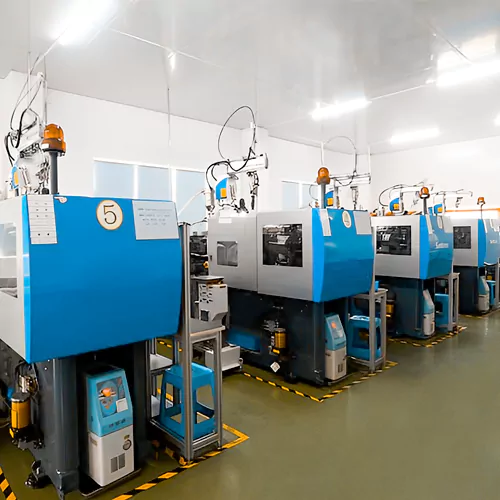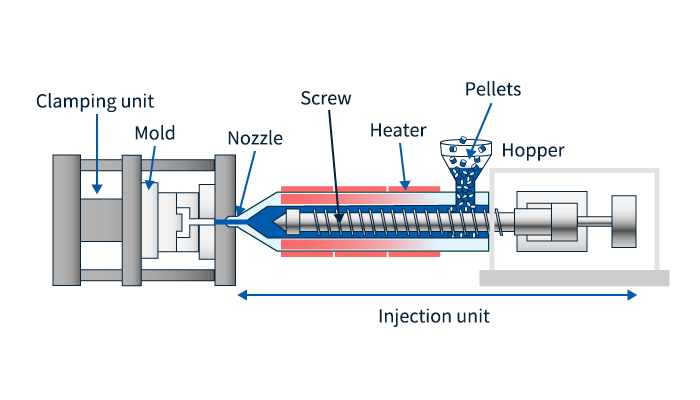The Effect of Plastic Injection Molding on Minimizing Manufacturing Expenses and Waste
The Effect of Plastic Injection Molding on Minimizing Manufacturing Expenses and Waste
Blog Article
Understanding the Basics of Plastic Injection Molding Processes
Plastic shot molding functions as a cornerstone of modern-day production, offering a methodical method to generating complex elements with precision. This procedure not just incorporates the basic steps of melting and injecting products right into mold and mildews yet also involves a nuanced understanding of different affecting variables, such as temperature and stress. As sectors increasingly require performance and top quality, the details of this method come to be more important. Checking out these necessary aspects might expose exactly how even small adjustments can result in considerable renovations in production results, increasing concerns regarding the capacity for advancement in this well established procedure.
What Is Plastic Shot Molding?
Plastic injection molding is an extensively used manufacturing process that transforms thermosetting and thermoplastic materials into precise and complicated forms. This strategy is favored for its capacity to produce high quantities of identical parts with phenomenal precision, making it an important approach in numerous industries, consisting of auto, consumer items, and clinical gadgets.
The process includes melting the selected plastic product and injecting it right into a mold under high stress. The mold, made to the specifications of the desired component, permits the molten plastic to form as it cools and strengthens. Once the product has set, the mold and mildew is opened, and the ended up element is ejected.
Plastic shot molding uses a number of advantages, including reduced waste, consistency in manufacturing, and the capability to integrate elaborate styles that might be testing with other making techniques. In addition, it sustains a wide range of materials, each supplying distinct properties that can be customized for particular applications. As industries proceed to innovate, plastic shot molding continues to be at the leading edge, enabling the advancement of sophisticated items that fulfill advancing customer demands.
The Shot Molding Process
The injection molding process is an advanced technique that entails numerous essential stages to generate high-quality plastic elements. At first, plastic pellets are fed into a warmed barrel where they are melted into a thick fluid. This molten plastic is after that injected under high pressure into a precision-engineered mold and mildew, which forms the material into the desired type.
Once the mold is filled up, the plastic is permitted to cool down and solidify, taking the form of the mold and mildew cavity. Air conditioning time is vital, as it influences the cycle time and the last buildings of the molded part. After sufficient cooling, the mold and mildew opens, and the finished component is expelled making use of ejector pins.

Products Utilized in Shot Molding
Different products can be used in the shot molding procedure, each offering distinct homes that satisfy specific applications. The most generally used materials consist of thermoplastics, thermosetting plastics, and elastomers.

Thermosetting plastics, like epoxy and phenolic resins, undertake a chemical modification during the healing process, leading to a rigid, stringent framework. These materials are optimal for applications needing high heat resistance and architectural honesty, often used in electrical insulators and automobile components.
Elastomers, including silicone and rubber-based materials, supply flexibility and resilience. Their one-of-a-kind properties make them ideal for applications that require elasticity, such as gaskets and seals.
Additionally, specialty materials like bio-based plastics and compounds are getting grip for their ecological advantages and enhanced efficiency features, expanding the extent of injection molding applications in numerous markets. Comprehending the residential or commercial properties of these products is vital for picking the proper kind for specific tasks.
Benefits of Injection Molding
Shot molding stands out as a highly reliable manufacturing process that provides numerous advantages for producing complicated get rid of precision. Among the most considerable benefits is the capability to create intricate styles that would certainly be tough or impossible to accomplish with other methods (Plastic Injection Molding). The procedure enables comprehensive functions and limited tolerances, making sure top quality components
Furthermore, shot molding is known for its quick production capabilities, making it a suitable option for high-volume manufacturing. Once the mold is created, components can be created quickly, lowering lead times and enhancing overall productivity. This performance not just decreases manufacturing costs but also provides a competitive side in the market.
The convenience of materials made use of in injection molding better boosts its appeal. A large range of thermoplastics and thermosetting polymers can be used, permitting makers to pick materials that ideal satisfy their specific requirements, including adaptability, warm, and toughness resistance.
Additionally, the process minimizes waste, as excess material can typically be recycled and recycled. This sustainability element adds to a decreased ecological effect, making shot molding an accountable production option. On the whole, the benefits of shot molding make it a recommended technique for several sectors.
Variables Impacting Item Quality
While countless variables can affect product top quality in injection molding, comprehending these aspects is vital for accomplishing optimal results. Key aspects consist of product selection, processing specifications, and mold and mildew layout.
Product selection plays a crucial duty, as different polymers display special residential properties that impact flowability, stamina, and thermal stability. Inadequate material option can result in defects such as warping or incomplete dental filling.
Processing specifications, consisting of cycle, stress, and temperature level time, should be thoroughly regulated. Variants in these settings can cause variances partly measurements and surface area coating. Excessively high temperatures may create destruction of the polymer, while inadequate stress can result in brief shots.
Mold style is equally important, as it figures out the circulation of the molten plastic and the cooling procedure. Inadequately created molds might lead to unequal cooling prices, causing residual stress and anxieties and dimensional errors.

Final Thought
To conclude, plastic shot molding functions as an important manufacturing process that allows the reliable production of top quality elements. Proficiency of the shot molding procedure, including the understanding of materials and the influence of different aspects on product top quality, is vital for accomplishing optimal outcomes. The advantages of this approach, such as cost-effectiveness and design flexibility, further highlight its significance throughout multiple sectors, solidifying its standing as a preferred choice for high-volume manufacturing.
Plastic shot molding offers as a foundation of modern manufacturing, supplying a systematic approach to generating complicated components with accuracy.Plastic injection molding supplies numerous advantages, including lowered waste, uniformity in production, and the ability to integrate intricate designs that might be testing with various other producing techniques (Plastic Injection Molding). As sectors our website proceed to innovate, plastic injection molding stays at the center, making it possible for the advancement of advanced products that satisfy advancing customer needs
The shot molding process is an innovative strategy that involves a number of crucial phases to create high-quality plastic components.In final thought, plastic injection molding offers as a crucial production procedure that makes it possible for the effective manufacturing of high-quality components.
Report this page